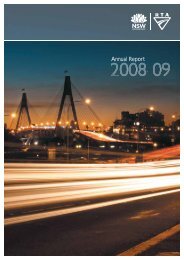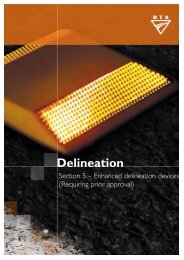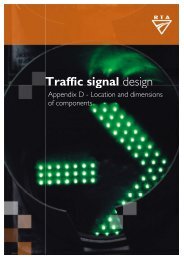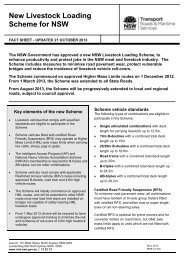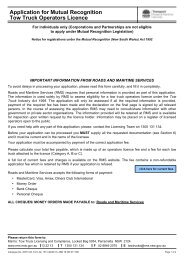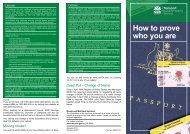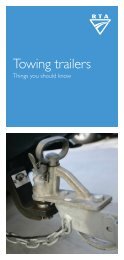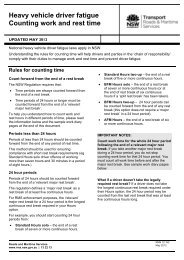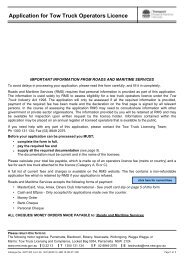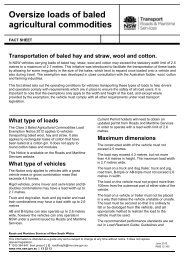A guide to older driver licensing - RTA
A guide to older driver licensing - RTA
A guide to older driver licensing - RTA
You also want an ePaper? Increase the reach of your titles
YUMPU automatically turns print PDFs into web optimized ePapers that Google loves.
A <strong>guide</strong> <strong>to</strong><br />
<strong>older</strong><br />
<strong>driver</strong><br />
<strong>licensing</strong>
Introduction<br />
1<br />
This <strong>guide</strong> explains the <strong>older</strong> <strong>driver</strong> <strong>licensing</strong> system, <strong>licensing</strong><br />
options and what the practical driving assessment involves. It<br />
does not give information on the road rules – this can be found<br />
in the Road Users’ Handbook or obtain more information from<br />
Road Rules 2008.<br />
The Road Rules 2008 and the Road Users’ Handbook are<br />
available for free on Roads and Maritime Services (RMS) website<br />
at www.rms.nsw.gov.au or the handbook can be purchased at<br />
any registry or by calling the Contact Centre on 13 22 13.<br />
OTHER PUBLICATIONS<br />
• A <strong>guide</strong> <strong>to</strong> the Driving Test<br />
A <strong>guide</strong> <strong>to</strong> <strong>older</strong> <strong>driver</strong> <strong>licensing</strong> 1
1<br />
Contents<br />
1. Road safety and the <strong>older</strong> <strong>driver</strong>. . . . . . . . . . . . 5<br />
2. The <strong>licensing</strong> system ........................6<br />
All licence h<strong>older</strong>s age 75 and over . .................6<br />
Heavy vehicle <strong>driver</strong>s age 80 and over ................6<br />
Class C (car) and class R (rider) licence h<strong>older</strong>s<br />
age 85 and over ..................................7<br />
3. Licensing options ............................8<br />
Modified licence .................................8<br />
Unrestricted <strong>driver</strong> licence .........................9<br />
Practical driving assessment ........................9<br />
4. Before you start .............................10<br />
Bribing people is against the law ...................10<br />
Your car must be roadworthy and ready <strong>to</strong> drive ......10<br />
Taking the driving assessment<br />
with an accredited assessor ........................10<br />
Taking the driving test with RMS ...................11<br />
Why a test can be cancelled .......................12<br />
2<br />
A <strong>guide</strong> <strong>to</strong> <strong>older</strong> <strong>driver</strong> <strong>licensing</strong>
1<br />
5. The practical assessment ...................13<br />
Applying the road rules .........................13<br />
Traffic lights and s<strong>to</strong>p signs .......................13<br />
Turns at intersections ............................14<br />
Keeping in the lane ..............................18<br />
Managing your speed .............................19<br />
Decision making ...............................20<br />
Observation ....................................20<br />
Giving way at intersections ........................21<br />
Giving way at T intersections ......................21<br />
Giving way <strong>to</strong> pedestrians .........................22<br />
Vehicle control .................................24<br />
Operating the controls ...........................24<br />
Signalling ......................................25<br />
6. Test results ................................. 26<br />
What happens after<br />
a driving assessment from home?. . . . . . . . . . . . . . . . . . . 26<br />
What happens after an RMS driving test? ............26<br />
Why you might fail ..............................26<br />
Serious Fail .....................................27<br />
Test termination ................................28<br />
Complaints .....................................29<br />
7. Glossary .................................... 30<br />
A <strong>guide</strong> <strong>to</strong> <strong>older</strong> <strong>driver</strong> <strong>licensing</strong> 3
1<br />
4<br />
A <strong>guide</strong> <strong>to</strong> <strong>older</strong> <strong>driver</strong> <strong>licensing</strong>
Road safety and the <strong>older</strong> <strong>driver</strong><br />
1<br />
Crash patterns for <strong>older</strong> <strong>driver</strong>s are significantly different <strong>to</strong><br />
those of other age groups. For <strong>driver</strong>s aged 80 and over, the<br />
most common crashes are intersection crashes, where the <strong>older</strong><br />
<strong>driver</strong> is turning right across traffic, and crashes where the <strong>older</strong><br />
<strong>driver</strong> drives off the road.<br />
Studies show that many <strong>older</strong> <strong>driver</strong>s compensate for their agerelated<br />
decline in driving competency by self restricting and<br />
limiting their driving, for example, by driving in local areas or<br />
avoiding complex, difficult situations.<br />
A <strong>guide</strong> <strong>to</strong> <strong>older</strong> <strong>driver</strong> <strong>licensing</strong> 5
21<br />
The <strong>licensing</strong> system<br />
The <strong>older</strong> <strong>driver</strong> <strong>licensing</strong> system is designed <strong>to</strong> balance the safety<br />
of road users and the general community with the continuing<br />
independence and mobility of <strong>older</strong> <strong>driver</strong>s.<br />
Licensing requirements from 75 years of age<br />
Age 75<br />
Start annual<br />
medical assessment<br />
RMS<br />
or<br />
Either undertake a practical<br />
driving assessment with RMS<br />
or with an accredited driving<br />
assessor.<br />
Age 85<br />
OR<br />
Switch <strong>to</strong> a<br />
modified licence<br />
6<br />
All licence h<strong>older</strong>s age 75 and over<br />
When you reach 75 years of age, you will need <strong>to</strong> have a medical<br />
examination each year <strong>to</strong> retain your licence. RMS will send you<br />
a form approximately eight weeks before your birthday for<br />
your doc<strong>to</strong>r <strong>to</strong> complete.<br />
If you will be unavailable <strong>to</strong> undertake your medical check-up<br />
at this time (for example, if you will be interstate or overseas on<br />
holidays) you can choose <strong>to</strong> undertake the check-up and submit<br />
your medical form up <strong>to</strong> six months before your birthday. In<br />
this case, you will need <strong>to</strong> obtain the medical report (Form<br />
1008) from a registry or the Contact Centre so you can take it<br />
A <strong>guide</strong> <strong>to</strong> <strong>older</strong> <strong>driver</strong> <strong>licensing</strong>
21<br />
<strong>to</strong> your doc<strong>to</strong>r <strong>to</strong> complete.<br />
If your doc<strong>to</strong>r considers you medically fit <strong>to</strong> drive, please take the<br />
completed form <strong>to</strong> our registry.<br />
If you want <strong>to</strong> restrict your driving, for instance, <strong>to</strong> certain times<br />
of the day or <strong>to</strong> the area you live in, you should discuss it with<br />
your doc<strong>to</strong>r when you have your examination.<br />
If your doc<strong>to</strong>r considers you medically fit <strong>to</strong> drive or wants <strong>to</strong><br />
refer you <strong>to</strong> another doc<strong>to</strong>r or for a driving assessment, they<br />
will send the completed form directly <strong>to</strong> RMS and you will be<br />
notified about the outcome shortly after.<br />
Heavy vehicle <strong>driver</strong>s age 80 and over<br />
If you have a licence <strong>to</strong> drive a heavy vehicle (LR <strong>to</strong> HC) you will<br />
also need <strong>to</strong> pass a driving test every year from age 80.<br />
Annual driving tests are required for multi-combination (MC)<br />
licence h<strong>older</strong>s from age 70 onwards.<br />
You must pass all assessments before your birthday.<br />
If you are unable <strong>to</strong> meet this time frame, contact<br />
RMS at the earliest opportunity.<br />
Class C (car) and class R (rider) licence h<strong>older</strong>s<br />
age 85 and over<br />
When you reach 85 years of age, in addition <strong>to</strong> the annual<br />
medical examination, you are required <strong>to</strong> pass a practical driving<br />
assessment every second year (age 85, 87, 89 etc) <strong>to</strong> retain<br />
your unrestricted <strong>driver</strong> licence. If you no longer require an<br />
unrestricted <strong>driver</strong> licence you can opt for a modified licence<br />
without the need for a practical driving assessment.<br />
A <strong>guide</strong> <strong>to</strong> <strong>older</strong> <strong>driver</strong> <strong>licensing</strong> 7
13<br />
Licensing options<br />
Modified licence<br />
A modified licence is a <strong>driver</strong> licence that allows the h<strong>older</strong><br />
<strong>to</strong> drive in their local area where they are familiar with the<br />
traffic conditions. Modified licence options are based on the<br />
individual’s personal driving needs. The limits on the modified<br />
licence are negotiated with the local registry manager based<br />
on the <strong>driver</strong>’s essential weekly journeys. If a person’s driving<br />
needs change they can convert back <strong>to</strong> an unrestricted licence at<br />
anytime, after they pass a practical driving assessment.<br />
If you hold a modified licence and change your residential<br />
address you must contact the manager of the local registry <strong>to</strong><br />
review the conditions on your licence.<br />
If you wish <strong>to</strong> apply for a modified licence, you should complete<br />
an application form and take it <strong>to</strong> your local registry. The registry<br />
manager will then discuss the application with you.<br />
Modified licences are only available for Class C (car) and Class<br />
R (rider) licences.<br />
You can convert <strong>to</strong> a modified licence at anytime, provided your<br />
<strong>driver</strong> licence is still current.<br />
The conditions on a modified licence are<br />
printed on the licence card and penalties apply if<br />
the conditions are breached.<br />
8<br />
A <strong>guide</strong> <strong>to</strong> <strong>older</strong> <strong>driver</strong> <strong>licensing</strong>
13<br />
Unrestricted <strong>driver</strong> licence<br />
If you need <strong>to</strong> retain your full <strong>driver</strong> licence you are required <strong>to</strong><br />
pass a practical driving assessment. You can choose between<br />
either:<br />
• A driving assessment from your home, conducted by<br />
a licensed driving instruc<strong>to</strong>r accredited by RMS, or<br />
• A driving test from an RMS testing centre, conducted<br />
by an RMS testing officer.<br />
Driving assessments conducted by accredited driving instruc<strong>to</strong>rs<br />
are on a ‘fee for service’ basis. You are able <strong>to</strong> choose any<br />
driving instruc<strong>to</strong>r accredited by RMS <strong>to</strong> deliver the assessment.<br />
The driving test conducted by RMS is provided at no charge.<br />
There is a limit of three attempts at RMS driving tests. However,<br />
there is no limit on the number of driving assessments you can<br />
take with an accredited assessor in the specified period.<br />
Practical driving assessment<br />
The driving assessment from home and RMS driving test use<br />
the same assessment criteria. The practical on road drive has<br />
set requirements. Generally you will be on the road for about<br />
15 <strong>to</strong> 20 minutes in duration. During the drive you will be<br />
directed where <strong>to</strong> drive. Your result will be based on your<br />
driving performance in a range of situations and your ability <strong>to</strong><br />
demonstrate safe driving behaviours.<br />
Some driving behaviours such as not s<strong>to</strong>pping at a ‘S<strong>to</strong>p’ sign<br />
or speeding are deemed <strong>to</strong> be ‘high risk’. If you behave this<br />
way during the test you will not pass, regardless of your overall<br />
driving performance.<br />
A <strong>guide</strong> <strong>to</strong> <strong>older</strong> <strong>driver</strong> <strong>licensing</strong> 9
41<br />
Before you start<br />
Bribing people is against the law<br />
It is illegal <strong>to</strong> offer, request or accept gifts, rewards, money or<br />
other favours in order <strong>to</strong> get a licence without passing the required<br />
tests and assessments. Penalties are severe and include fines and<br />
imprisonment. All cases of corruption will be investigated and<br />
strong action will be taken against all those involved.<br />
If you know or believe that someone has got or is about <strong>to</strong> get a<br />
NSW licence by offering or responding <strong>to</strong> a request for a bribe<br />
– or if you suspect or know of any other corruption involving<br />
an RMS employee – telephone RMS on 1800 043 642 (free call)<br />
or the Independent Commission Against Corruption (ICAC) on<br />
(02) 8281 5999.<br />
Your car must be roadworthy and ready <strong>to</strong> drive<br />
For the practical driving assessment your vehicle must be registered<br />
and roadworthy. The testing officer/accredited assessor will check<br />
<strong>to</strong> make sure that your vehicle meets the required safety standard.<br />
See the checklist in Section 6 Test results.<br />
Taking the driving assessment with an<br />
accredited assessor<br />
If you choose <strong>to</strong> do a driving assessment with an accredited<br />
assessor you will need <strong>to</strong> contact them directly. A list of driving<br />
instruc<strong>to</strong>rs accredited by RMS <strong>to</strong> conduct the assessments can<br />
be obtained either:<br />
• Online at www.my<strong>RTA</strong>.com.<br />
• By calling 13 22 13.<br />
• Or going <strong>to</strong> our registry or agency.<br />
10<br />
A <strong>guide</strong> <strong>to</strong> <strong>older</strong> <strong>driver</strong> <strong>licensing</strong>
41<br />
When booking an assessment with an accredited assessor confirm<br />
all the fees they will be charging. The fees for the assessment are<br />
paid directly <strong>to</strong> the assessor. Generally the overall time for the<br />
assessment session will be about one hour.<br />
As accredited assessors are all licensed driving instruc<strong>to</strong>rs you<br />
may choose <strong>to</strong> have some refresher training with them prior<br />
<strong>to</strong> attempting your assessment. Refresher training will require<br />
additional time and may incur some additional fees. RMS<br />
recommend you compare the services and fees of a number of<br />
accredited providers prior <strong>to</strong> engaging their services.<br />
Taking the driving test at RMS<br />
If you choose <strong>to</strong> take the driving test with RMS, you need <strong>to</strong><br />
make a booking either:<br />
• Online at www.my<strong>RTA</strong>.com.<br />
• By calling 13 22 13.<br />
• Or going <strong>to</strong> a registry or agency.<br />
Should you wish <strong>to</strong> change or cancel your booking, you may do so.<br />
This must be done at least 24 hours prior <strong>to</strong> the test date.<br />
When you go <strong>to</strong> an RMS testing centre for the driving test, plan<br />
<strong>to</strong> arrive at the testing centre on time for your appointment.<br />
Give your booking confirmation slip <strong>to</strong> the person at the<br />
counter and they will refer you <strong>to</strong> a testing officer.<br />
You can switch between RMS tests and<br />
assessments by accredited assessors, however you<br />
should note that if you demonstrate extremely<br />
unsafe driving behaviour and score a ‘serious fail’<br />
result, your licence will be cancelled.<br />
A <strong>guide</strong> <strong>to</strong> <strong>older</strong> <strong>driver</strong> <strong>licensing</strong> 11
41<br />
The testing officer will ask you <strong>to</strong> sign the test sheet. Remember<br />
<strong>to</strong> ask any questions before you start. The testing officer cannot<br />
tell you how <strong>to</strong> drive or coach you during the test as it is an<br />
assessment of your ability <strong>to</strong> drive on your own.<br />
After the test, the testing officer will give you feedback on your<br />
test performance. Testing officers will provide general comments<br />
rather than discuss specific situations or events.<br />
At the completion of the assessment you will receive a driving<br />
test report that shows the areas where you did well and where<br />
you may need <strong>to</strong> improve.<br />
A moni<strong>to</strong>ring officer may sit in on your<br />
test/assessment. The moni<strong>to</strong>ring officer’s job<br />
is <strong>to</strong> watch the testing officer/accredited<br />
assessor and make sure that the drive is conducted<br />
properly. Nobody, other than the testing officer/<br />
accredited assessor and moni<strong>to</strong>ring officer, is<br />
allowed <strong>to</strong> be in the vehicle with you during the<br />
practical drive.<br />
Why a test can be cancelled<br />
If there is any suspicion that you have recently taken alcohol or<br />
another drug, the test will be cancelled. If you offer money or<br />
some other bribe <strong>to</strong> the testing officer, the test will be s<strong>to</strong>pped,<br />
you will be taken <strong>to</strong> a police station and may be charged with<br />
offering a bribe.<br />
12<br />
A <strong>guide</strong> <strong>to</strong> <strong>older</strong> <strong>driver</strong> <strong>licensing</strong>
The practical assessment<br />
15<br />
Safe driving requires a combination of sound knowledge of the<br />
road rules, good decision-making ability and vehicle control.<br />
The practical driving assessment will check you still have all<br />
these skills essential <strong>to</strong> safe driving.<br />
In all the diagrams in this handbook you are<br />
always the blue car.<br />
Applying the road rules<br />
During your assessment you must comply with all regula<strong>to</strong>ry<br />
traffic signs, signals and road markings.<br />
Traffic lights and s<strong>to</strong>p signs<br />
When approaching traffic lights that are green, check your<br />
mirrors and be prepared <strong>to</strong> s<strong>to</strong>p. You must s<strong>to</strong>p at a yellow light,<br />
unless sudden braking might cause a crash.<br />
At red traffic lights and ‘S<strong>to</strong>p’ signs you must s<strong>to</strong>p completely<br />
before reaching the ‘S<strong>to</strong>p’ line with no part of your vehicle over<br />
the line.<br />
You must completely s<strong>to</strong>p at ‘S<strong>to</strong>p’ lines.<br />
A <strong>guide</strong> <strong>to</strong> <strong>older</strong> <strong>driver</strong> <strong>licensing</strong> 13
15<br />
Final position at a s<strong>to</strong>p line<br />
If initially you s<strong>to</strong>p more than one car length<br />
back from the s<strong>to</strong>p line you must move up<br />
and s<strong>to</strong>p at the correct position before<br />
proceeding. After you have s<strong>to</strong>pped in the correct<br />
position you may then move forward<br />
if you need a better view.<br />
Turns at intersections<br />
Your road position when making turns is important <strong>to</strong> ensure a<br />
smooth and safe flow of traffic.<br />
When turning left you must approach in the left lane or any<br />
marked left turn lanes on laned roads, or as far left as you can<br />
when on unmarked roads.<br />
Approach left turns as far left as you can.<br />
14<br />
A <strong>guide</strong> <strong>to</strong> <strong>older</strong> <strong>driver</strong> <strong>licensing</strong>
15<br />
As you finish a left turn, exit in<strong>to</strong> the lane or part of the road<br />
that is best for the traffic conditions. Your choice will depend<br />
on where you are going next, whether cars are parked in the left<br />
lane and other traffic conditions.<br />
However, when there are multiple turning lanes, you must finish<br />
in a permissible lane.<br />
You can turn in<strong>to</strong> either lane, depending on traffic.<br />
When there are multiple turning lanes, you must finish in<br />
a permissible lane.<br />
A <strong>guide</strong> <strong>to</strong> <strong>older</strong> <strong>driver</strong> <strong>licensing</strong> 15
51<br />
When turning right you must approach in the right lane or any<br />
marked right turn lanes on laned roads, or by keeping <strong>to</strong> the<br />
left of, but as close as practical <strong>to</strong>, the centre of the road on<br />
unmarked roads.<br />
In marked lanes stay in the same lane.<br />
In marked lanes you must stay in the same lane as you go from<br />
one road <strong>to</strong> another.<br />
To protect you from being pushed in<strong>to</strong><br />
the oncoming traffic if hit from behind,<br />
you should keep your steering straight<br />
while waiting <strong>to</strong> turn right.<br />
16<br />
A <strong>guide</strong> <strong>to</strong> <strong>older</strong> <strong>driver</strong> <strong>licensing</strong>
15<br />
When turning right, steer <strong>to</strong> the right of an imaginary centre of<br />
the intersection. This allows vehicles opposite you <strong>to</strong> also turn<br />
right. As you exit you must keep <strong>to</strong> the left of the centre of the<br />
road.<br />
B<br />
A<br />
Turning vehicles pass in front of each other.<br />
When turning right in<strong>to</strong> a one-way street, approach and exit as<br />
close as possible <strong>to</strong> the right hand side of the road.<br />
A <strong>guide</strong> <strong>to</strong> <strong>older</strong> <strong>driver</strong> <strong>licensing</strong> 17
51<br />
On multi-laned roundabouts position your vehicle in accordance<br />
with the road markings for the direction you intend <strong>to</strong> travel.<br />
You must exit in a permissible lane.<br />
Indicate left when leaving the roundabout.<br />
Keeping in the lane<br />
During the test you will be expected <strong>to</strong> maintain a safe, legal<br />
position on the road.<br />
If you unnecessarily drive on the wrong side of the road, or<br />
unnecessarily cross any edge lines or lane markings, you will not<br />
pass.<br />
18<br />
A <strong>guide</strong> <strong>to</strong> <strong>older</strong> <strong>driver</strong> <strong>licensing</strong>
15<br />
You may cross an edge line for up <strong>to</strong> 100 metres when turning<br />
at an intersection.<br />
You must also keep in your lane when turning at an<br />
intersection as mounting or straddling (one wheel either side of)<br />
a traffic dome, mounting the kerb or <strong>to</strong>uching the centre of a<br />
roundabout may result in a fail.<br />
Managing your speed<br />
You must drive at a safe and legal speed, managing your speed<br />
<strong>to</strong> suit traffic, weather and road conditions. If you exceed the<br />
posted speed limit during the test you will fail.<br />
Be aware of changes in speed limits, in particular<br />
‘School Zone’ and their operating times.<br />
Adjust your speed <strong>to</strong> maintain a safe distance from the car in<br />
front and slow down if you do not have a clear view of the road<br />
ahead. Situations where your vision may be reduced include:<br />
blind corners, blocked intersections, crests and poor weather<br />
conditions.<br />
A <strong>guide</strong> <strong>to</strong> <strong>older</strong> <strong>driver</strong> <strong>licensing</strong> 19
51<br />
Decision making<br />
Many <strong>older</strong> <strong>driver</strong> crashes are due <strong>to</strong> poor gap selection. A<br />
critical decision must be made whenever you enter traffic,<br />
change lanes, cross or turn at an intersection. You must give way<br />
<strong>to</strong> any vehicle that has priority over you at an intersection and<br />
if required give way when entering a traffic stream, merging or<br />
lane changing.<br />
Observation<br />
Observation is essential for making good driving decisions.<br />
Keep your eyes moving, checking in one area for no more than<br />
a couple of seconds and then move your eyes <strong>to</strong> another area.<br />
Good <strong>driver</strong>s check their rear vision mirrors before they slow<br />
down or change direction and they turn their head <strong>to</strong> check their<br />
blind spot is clear before changing lane, merging or diverging.<br />
Blind<br />
spot area<br />
Turn your head <strong>to</strong> check your blind spot is clear.<br />
20<br />
A <strong>guide</strong> <strong>to</strong> <strong>older</strong> <strong>driver</strong> <strong>licensing</strong>
15<br />
Giving way at intersections<br />
The testing officer will be checking that you proceed only when<br />
there is a safe gap in the traffic and that you are not affecting<br />
other <strong>driver</strong>s or pedestrians.<br />
A safe gap ensures that other vehicles do not need <strong>to</strong> change<br />
their speed or position. When turning across traffic make sure<br />
your vehicle will be well clear of the intersection before the<br />
approaching vehicles arrive. When joining a traffic stream,<br />
select a gap that allows you <strong>to</strong> reach the traffic speed before the<br />
approaching vehicles are <strong>to</strong>o close.<br />
Giving way at T intersections<br />
At T intersections the vehicle travelling on the road that ends<br />
must give way <strong>to</strong> any pedestrians crossing or vehicles travelling<br />
on the road that continues unless otherwise signposted.<br />
Car A must give way <strong>to</strong> Car B.<br />
Take extra care when turning at intersections,<br />
as many <strong>older</strong> <strong>driver</strong>s crash in these situations.<br />
A <strong>guide</strong> <strong>to</strong> <strong>older</strong> <strong>driver</strong> <strong>licensing</strong> 21
51<br />
This diagram shows a T intersection where the continuing road<br />
(which is marked with broken white lines) goes around a corner.<br />
Car B must signal <strong>to</strong> leave the continuing road and enter the<br />
terminating road.<br />
Car B must give way <strong>to</strong> Car A.<br />
Giving way <strong>to</strong> pedestrians<br />
You must give way <strong>to</strong> pedestrians at marked crossings and<br />
intersections and give way <strong>to</strong> pedestrians crossing the road in<strong>to</strong><br />
which you are turning. Even if there is no marked pedestrian<br />
crossing, you must give way <strong>to</strong> pedestrians – if there is any<br />
danger of colliding with them.<br />
22<br />
A <strong>guide</strong> <strong>to</strong> <strong>older</strong> <strong>driver</strong> <strong>licensing</strong>
15<br />
You must also give way <strong>to</strong> pedestrians if there is any danger of colliding<br />
with them.<br />
When the flags are displayed at a ‘Children’s Crossing’ you must<br />
slow down and s<strong>to</strong>p before the S<strong>to</strong>p line if a pedestrian is on or<br />
entering the crossing. You must not proceed until all pedestrians<br />
have left the crossing.<br />
As you approach a pedestrian crossing or children’s crossing<br />
where a School Crossing Supervisor is displaying a ‘STOP<br />
Children Crossing’ sign, you must slow down and s<strong>to</strong>p. You<br />
may proceed when the School Crossing Supervisor no longer<br />
displays the sign in your direction or has indicated it is safe for<br />
you <strong>to</strong> proceed.<br />
S<strong>to</strong>p signs may be placed at an intersection<br />
immediately after a pedestrian crossing. You must<br />
s<strong>to</strong>p at the s<strong>to</strong>p sign even if you have already<br />
s<strong>to</strong>pped at the pedestrian crossing.<br />
A <strong>guide</strong> <strong>to</strong> <strong>older</strong> <strong>driver</strong> <strong>licensing</strong> 23
51<br />
Vehicle control<br />
Your ability <strong>to</strong> control the vehicle is assessed by the way you<br />
handle the tasks involved.<br />
Operating the controls<br />
Some of the driving tasks that will be observed and recorded are<br />
listed here:<br />
• Effective operation of the accelera<strong>to</strong>r and brakes.<br />
• Coordination of the clutch and gear lever <strong>to</strong> make<br />
smooth gear changes.<br />
• Effective steering with both hands on the steering wheel<br />
(except when using another control). You may use either<br />
‘hand-over-hand’ or ‘push-pull’ method with hands on the<br />
outside of the steering wheel.<br />
Maintaining vehicle control is very important. Many crashes<br />
happen where the <strong>older</strong> <strong>driver</strong> runs off the road.<br />
Running off the road on a straight<br />
section and hitting an object or<br />
parked vehicle.<br />
Running off the road on a curve<br />
or bend and hitting an object or<br />
parked vehicle.<br />
24<br />
A <strong>guide</strong> <strong>to</strong> <strong>older</strong> <strong>driver</strong> <strong>licensing</strong>
15<br />
You must be confident in your use of all controls and be able<br />
<strong>to</strong> operate them without being distracted. You will not pass if<br />
you:<br />
• Allow the vehicle <strong>to</strong> roll back <strong>to</strong>o far when moving off.<br />
• Skid or spin the wheels.<br />
• Clutch coast (allow the vehicle <strong>to</strong> roll along with<br />
your foot on the clutch) or coast in neutral.<br />
• Do not maintain effective control of the steering wheel.<br />
Signalling<br />
You must indicate <strong>to</strong> let others know what you plan <strong>to</strong> do. Give<br />
plenty of warning by signalling before you turn left or right, or<br />
change lanes. Make sure your indica<strong>to</strong>r is turned off after each<br />
turn or lane change.<br />
A <strong>guide</strong> <strong>to</strong> <strong>older</strong> <strong>driver</strong> <strong>licensing</strong> 25
61<br />
Test results<br />
What happens after a driving assessment from home?<br />
When you pass an assessment with an accredited assessor<br />
they will give you a signed assessment result form. Take the<br />
assessment result form <strong>to</strong> our registry for recording of the result.<br />
If the pass result is not recorded with RMS by the required date<br />
your <strong>driver</strong> licence will be suspended and you will not be allowed<br />
<strong>to</strong> drive until the records are updated.<br />
If you did not pass, the assessor will provide you with detailed<br />
feedback on where you need <strong>to</strong> improve your driving. You may<br />
choose <strong>to</strong> have some training before your next assessment.<br />
What happens after RMS driving test?<br />
When you return <strong>to</strong> the registry the testing officer will ask you<br />
<strong>to</strong> wait inside while your result is recorded. Your testing officer<br />
will call you <strong>to</strong> the counter <strong>to</strong> tell you your result.<br />
You will be given a test report that shows where you did well<br />
and where you may need <strong>to</strong> improve. Testing officers will only<br />
provide general comments and are not permitted <strong>to</strong> discuss<br />
specific situations or events. Remember, testing officers are not<br />
driving instruc<strong>to</strong>rs and it is not their job <strong>to</strong> give you a driving<br />
lesson.<br />
Why you might fail<br />
This <strong>guide</strong> shows examples of what you must do <strong>to</strong> drive safely<br />
and pass the practical driving assessment. However, some driving<br />
behaviours such as not s<strong>to</strong>pping at a ‘S<strong>to</strong>p’ sign or speeding are<br />
deemed <strong>to</strong> be ‘high risk’ and are classed as ‘fail items’. If you<br />
commit a ‘fail item’ during the test you will not pass, regardless<br />
of your overall driving performance.<br />
26<br />
A <strong>guide</strong> <strong>to</strong> <strong>older</strong> <strong>driver</strong> <strong>licensing</strong>
16<br />
Here is the full list of ‘fail items’ that can be recorded on a<br />
driving assessment.<br />
1. Disobeying traffic signs, signals or road markings.<br />
2. Failing <strong>to</strong> give way when necessary.<br />
3. Colliding with a vehicle, pedestrian or object.<br />
4. Performing an illegal act or manoeuvre.<br />
5. Exceeding the speed limit.<br />
6. Action requiring testing officer intervention.<br />
7. Causing a dangerous situation.<br />
8. Failing <strong>to</strong> maintain proper control of the vehicle.<br />
In most circumstances, even if you commit a ‘fail item’, your<br />
test will continue and you will be given a full assessment of your<br />
performance. However, if you do anything which is unsafe or<br />
dangerous and there is an obvious danger <strong>to</strong> the public you will<br />
not be permitted <strong>to</strong> complete the test and the testing officer may<br />
drive you back <strong>to</strong> the registry.<br />
Serious Fail<br />
A ‘Serious Fail’ result may be recorded for a practical driving<br />
assessment where your driving behaviours represent a danger <strong>to</strong><br />
yourself or other road users.<br />
If a ‘Serious Fail’ result is recorded your <strong>driver</strong> licence will be<br />
cancelled. If your licence is cancelled due <strong>to</strong> a ‘Serious Fail’<br />
result, you may have a right of appeal through the Court.<br />
A <strong>guide</strong> <strong>to</strong> <strong>older</strong> <strong>driver</strong> <strong>licensing</strong> 27
61<br />
Test termination<br />
Termination criteria applies <strong>to</strong> situations not concerned with<br />
the applicant’s driving performance for example your test will<br />
be terminated if:<br />
1. The testing vehicle is not roadworthy.<br />
Use this checklist <strong>to</strong> make sure your car is roadworthy:<br />
• Indica<strong>to</strong>rs and brake lights work.<br />
• Vehicle is registered.<br />
• Tyres are correctly inflated and have acceptable<br />
tread depth.<br />
• Wheel rims are undamaged.<br />
• Windscreen is clean and undamaged.<br />
• An approved lap/sash seatbelt is fitted for the<br />
testing officer/accredited assessor.<br />
• There is no significant body damage or sharp edges.<br />
• Mirrors are in good order.<br />
• Front passenger door and window operate.<br />
• Speedometer operates.<br />
• Head restraints must be fitted <strong>to</strong> vehicles that<br />
were manufactured after 1 January 1972.<br />
• Functioning dual controls must be fitted if you<br />
are taking the test in an instruc<strong>to</strong>r’s vehicle<br />
and the dual accelera<strong>to</strong>r must be rendered<br />
inoperable during the test.<br />
2. The testing vehicle is unsuitable for the<br />
class of licence test.<br />
28<br />
A <strong>guide</strong> <strong>to</strong> <strong>older</strong> <strong>driver</strong> <strong>licensing</strong>
16<br />
3. The testing vehicle is not suitable for<br />
the licence condition or type of disability.<br />
4. The testing vehicle breaks down during the test,<br />
or a large number of assessments are missed<br />
while off course.<br />
5. A bribe or inducement is offered, or any other<br />
form of corrupt conduct is suggested.<br />
6. The <strong>driver</strong> is, or is suspected <strong>to</strong> be, under<br />
the influence of drugs or alcohol.<br />
7. A crash occurs during the test, regardless of<br />
who is at fault.<br />
8. The applicant is ill, <strong>to</strong> the extent that they<br />
may not be able <strong>to</strong> drive safely.<br />
9. Weather conditions are bad and make<br />
the driving task <strong>to</strong>o demanding.<br />
A <strong>guide</strong> <strong>to</strong> <strong>older</strong> <strong>driver</strong> <strong>licensing</strong> 29
61<br />
Complaints<br />
RMS tries <strong>to</strong> make sure that your test will be conducted fairly<br />
and courteously. If you are genuinely not satisfied with the way<br />
an RMS test was conducted after you get the results, please<br />
contact the manager at the registry where you <strong>to</strong>ok the test. The<br />
manager will look in<strong>to</strong> your complaint and discuss the matter<br />
with you.<br />
If you are not satisfied with the service provided by an accredited<br />
assessor, please contact the manager of the driving school <strong>to</strong><br />
further discuss the matter.<br />
30<br />
A <strong>guide</strong> <strong>to</strong> <strong>older</strong> <strong>driver</strong> <strong>licensing</strong>
Glossary<br />
17<br />
Accredited assessor – A licensed driving instruc<strong>to</strong>r accredited<br />
by RMS <strong>to</strong> conduct <strong>older</strong> <strong>driver</strong> assessments.<br />
Driving assessment – An on-road assessment of driving<br />
competency performed by an accredited assessor, generally<br />
conducted from the <strong>driver</strong>’s residence. See also driving test.<br />
Driving instruc<strong>to</strong>r – A person licensed by RMS <strong>to</strong> provide<br />
driving instruction for fee or reward.<br />
Driving test – An on-road assessment of driving competency<br />
performed by RMS testing officer, conducted from an RMS<br />
testing centre. See also driving assessment.<br />
Intersection crashes – A collision between two vehicles<br />
at the junction of two roads.<br />
Modified licence – A licence that allows the h<strong>older</strong> <strong>to</strong> access<br />
services in their local area.<br />
Moni<strong>to</strong>ring officer – A person employed by RMS<br />
<strong>to</strong> moni<strong>to</strong>r quality and consistency of driving assessments and<br />
tests.<br />
Practical driving assessment – A term <strong>to</strong> cover both<br />
RMS driving test and a driving assessment performed<br />
by an accredited assessor. See also driving assessment<br />
and driving test.<br />
RMS testing centre – Locations where driving tests are<br />
conducted including, Roads and Maritime Services registries,<br />
Council Agencies, Government Access Centres (GACs) and<br />
itinerant testing locations.<br />
RMS testing officer – A person employed by RMS<br />
<strong>to</strong> conduct driving tests.<br />
Unrestricted <strong>driver</strong> licence – A <strong>driver</strong> licence without<br />
restrictions or conditions.<br />
A <strong>guide</strong> <strong>to</strong> <strong>older</strong> <strong>driver</strong> <strong>licensing</strong> 31
1<br />
Notes<br />
32<br />
A <strong>guide</strong> <strong>to</strong> <strong>older</strong> <strong>driver</strong> <strong>licensing</strong>
For further enquiries:<br />
www.rms.nsw.gov.au<br />
13 22 13<br />
Roads and Maritime Services<br />
The information in this handbook is intended as a <strong>guide</strong> only and is subject <strong>to</strong> change<br />
at any time without notice. It does not replace the legislation.<br />
July 2013<br />
RMS/Pub. 08.371<br />
ISSN 1321–7518 Cat No. 45071419



